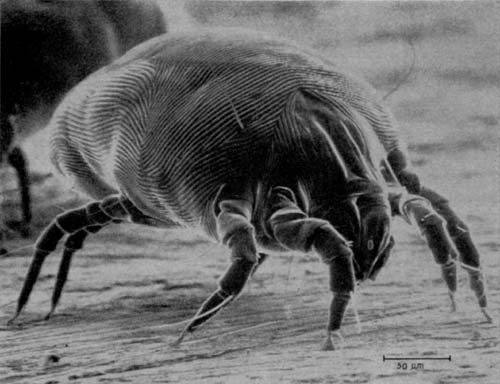Allergen
Editor-In-Chief: C. Michael Gibson, M.S., M.D. [1]
Associate Editor-In-Chief: Cafer Zorkun, M.D., Ph.D. [2]
Overview
An allergen is a nonparasitic antigen capable of stimulating a type-I hypersensitivity reaction in atopic individuals.[1]
Most humans mount significant IgE responses only as a defense against parasitic infections. However, some individuals mount an IgE response against common environmental antigens. This hereditory predisposition is called atopy. In atopic individuals, non-parasitic antigens stimulate inappropriate IgE production, leading to type I hypersensitivity. Sensitivities vary from one person to another and it is possible to be allergic to an extraordinary range of substances.
Types of allergies
Dust, pollen and pet dander are all common allergens, but it is possible to be allergic to anything from chlorine to perfume. Food allergies are not as common as food sensitivity, but some foods such as peanuts (really a legume), nuts, seafood and shellfish are the cause of serious allergies in many people.
Officially, the Food and Drug Administration does recognize 8 foods as being common for allergic reactions in a large segment of the sensitive population, which includes, peanuts, tree nuts, eggs, milk, shellfish, fish, wheat and their derivatives, soy and their derivatives, and sulphites (chemical based, often found in flavors and colors in foods) at 10ppm and over. See the FDA website for complete details. It should be noted that other countries, due to differences in genetic profiles of its citizens and different levels of exposure to different foods, the "official" allergen list will change. Canada recognizes all eight of the allergens recognized by the US, and also recognizes sesame seeds.[2]
A few people have been recorded to be allergic to certain chemicals found in almost all water, and even water itself (see Aquagenic pruritus).
Poison ivy is a plant that will cause an allergic reaction in 70-85% of humans. But, given enough repeated contact—like any allergy, most human bodies will learn to fight the allergen.
An allergic reaction can be caused by any form of direct contact with the allergen—eating or drinking a food you are sensitive to (ingestion), breathing in pollen, perfume or pet dander (inhalation), or brushing your body against an allergy-causing plant (direct contact, generally resulting in hives). Other common causes of serious allergy are wasp, fire ant and bee stings, penicillin, and latex. An extremely serious form of an allergic reaction, which can kill in mere minutes, is called anaphylaxis. One form of treatment is the administration of sterile epinephrine (via "Epi-Pen") to the person experiencing anaphylaxis, which suppresses the body's overreaction to the food ingested, and allows for time to be transported to a medical facility (it does not "cure" the allergic reaction).
Common allergens


In addition to foreign proteins found in foreign serum (from blood transfusions) and vaccines, common allergens include:
- Animal products
- cat]s
- fur and dander
- cockroach calyx
- dust mite excretion
- Drugs
- penicillin
- sulfonamides
- salicylates (also found naturally in numerous fruits)
- local anaesthetics
- Foods
- Insect stings
- bee sting venom
- wasp sting venom
- mosquito stings
- Mold spores
- Other
- latex
- metal
- Plant pollens (hay fever)
- grass — ryegrass, timothy-grass
- weeds — ragweed, plantago, nettle, artemisia vulgaris, chenopodium album, sorrel
- trees — birch, alder, hazel, hornbeam, aesculus, willow, poplar, platanus, tilia, olea
See also
- Asthma
- Bioaerosol
- Eczema
- Eggshell skull
- Hypoallergenic
- Toxin
References
- ↑ Goldsby, Richard A. et al.,Immunology. 5th ed. New York: W.H. Freeman and Company, 2000.
- ↑ "Health Canada: Food Allergies". Retrieved 2007-06-09.
- ↑ Bublin M; Radauer C; Wilson IBH; Kraft D; Scheiner O; Breiteneder H; Hoffmann-Sommergruber K (2003), "Cross-reactive N-glycans of Api g 5, a high molecular weight glycoprotein allergen from celery, are required for immunoglobulin E binding and activation of effector cells from allergic patients", FASEB, 17: 1697–1699
bg:Алерген
ca:Allergogen
cs:Alergen
da:Allergen
de:Allergen
et:Allergeen
eo:Alergeno
fi:Allergeeni
he:אלרגן
ia:Allergene
it:Allergene
ko:알레르겐
nl:Allergeen
no:Allergen
sv:Allergen